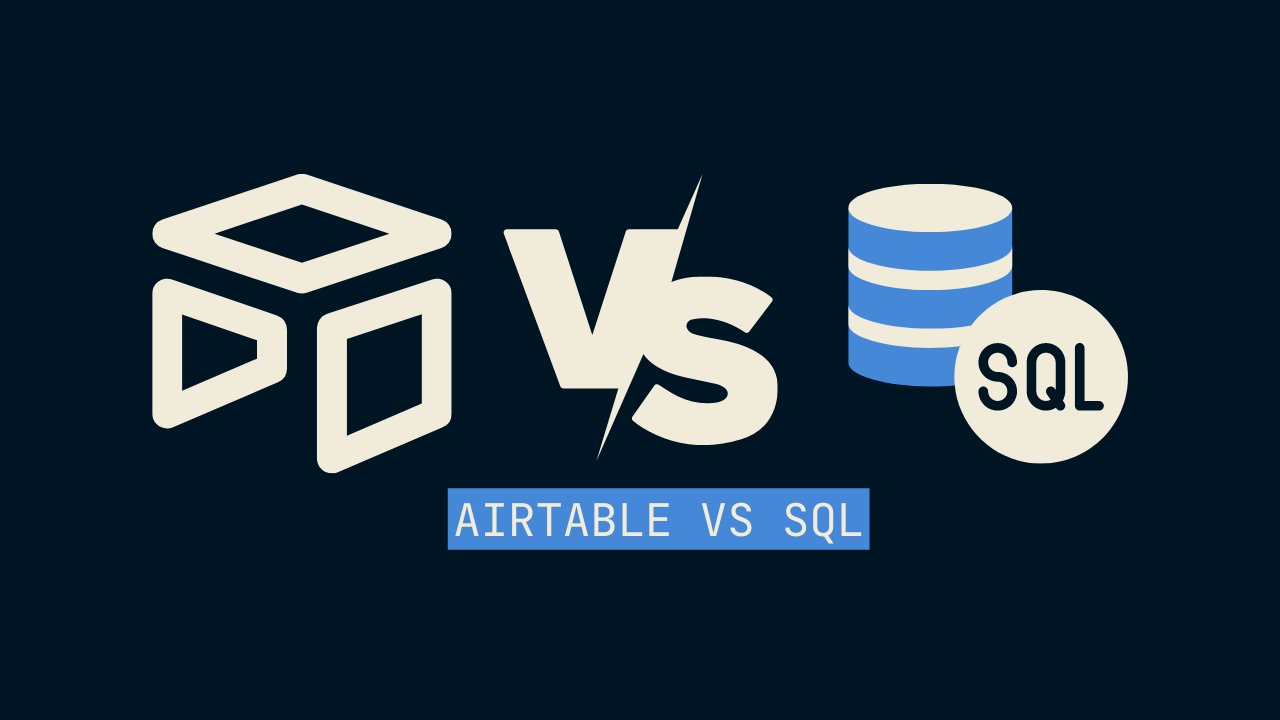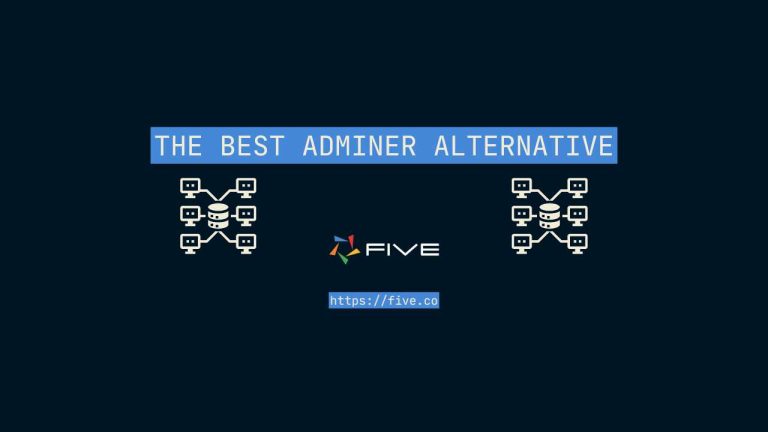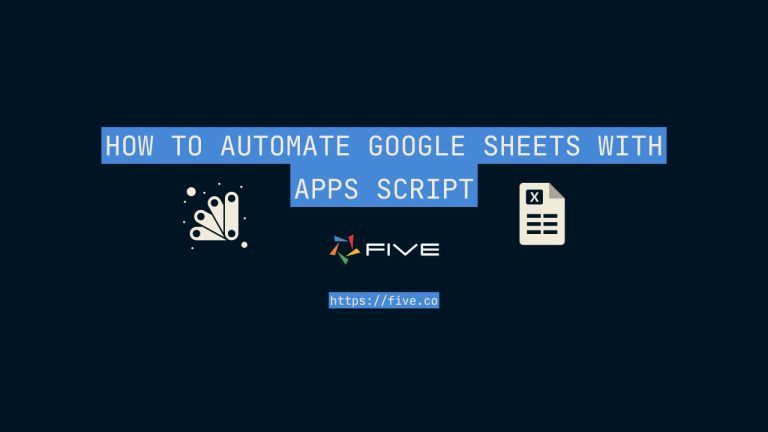Airtable vs SQL: 7 Pros and Cons of Using Airtable vs a Relational Database
Airtable vs SQL: 7 Pros and Cons of Using Airtable vs a Relational Database
For many small- and medium-sized businesses (SMBs), Airtable has become the go-to solution for migrating from spreadsheets to web-based data storage. Primarily used for organizing, managing, and collaborating on data in a flexible and visual way, Airtable is loved by millions of business users as a collaborative data storage and processing solution with a clean and user-friendly user interface.
But how does using Airtable compare to using a traditional relational database? Relational databases are the hidden workhorses of the internet, used by millions of businesses to reliably store and process data. If Airtable is so great, why do relational databases persist?
In this article, we delve deeper into the pros and cons of Airtable vs SQL. Last, we will introduce Five, an online database builder that lets users rapidly create custom databases and web apps.

What is Airtable?
Airtable is a cloud-based database that allows non-engineers to design and use a database on the web.
Airtable combines the functionalities of a spreadsheet and a database. It offers users a flexible and intuitive way to organize, manage, and take action on their data. It also allows for easy collaboration, customization, and integration with other tools, making it a versatile solution for a wide range of personal and professional use cases. And it is suitable for users who do not have a background in relational databases or SQL, as it can be set up and used without coding.
What Are Typical Airtable Use Cases?
Airtable is widely used by individuals, teams, and organizations across various industries to streamline workflows, track progress, and centralize information in a user-friendly manner.
It is primarily used for organizing, managing, and collaborating on data in a flexible and visual way. It can be used to create databases, track projects, build content management systems, manage tasks, organize inventories, plan events, build customer relationship systems (CRM), and much more.
With its spreadsheet-like interface and customizable fields, Airtable enables users to structure and categorize their data according to their specific needs. It gives users the familiarity of a spreadsheet, but the functionality of a sophisticated web app. Not surprisingly, some refer to Airtable as “Microsoft Excel on steroids”.
What is SQL?
SQL, or Structured Query Language, is a programming language for storing and processing information in a relational database. Relational databases are the de facto standard for storing data in a highly efficient manner.
SQL is the tool that data analysts, database administrators, or anyone else who works with data stored in a relational database uses to interact with this data. Think of it as the language that helps you ask questions about your data, such as “What were my sales last month?”, or “Which customer bought the most in June?”. SQL can be used to express these data questions in a manner that a computer can understand them.
Relational databases and tools, such as Five, MySQL Workbench, or legacy solutions such as Microsoft Office Access, all rely on SQL to work with data. Unlike many other computer languages, SQL is not difficult to read and understand. SQL uses many English words such as SELECT, WHERE, or FROM and even for a novice programmer, a query written in SQL is usually easily understandable.
7 Pros and Cons of Using Airtable Vs SQL
Let’s say, you are in the process of modernizing your internal data storage and need to migrate everything off of spreadsheets. Should you go with Airtable, or move your data into a SQL, relational database?
There are pros and cons to both. Let’s explore several criteria to compare Airtable with SQL.
Note that we are comparing Airtable and SQL from the perspective of a software developer. If you are entirely new to relational databases, Airtable is a good place to start. For non-engineers, the learning curve for relational databases is steeper than it is for Airtable.
1. User Friendliness, Collaboration, and Flexibility: Ease of Getting Started
Airtable shines in its user-friendly interface, which resembles a spreadsheet rather than complex tables and queries. This simplicity makes it incredibly intuitive for users to create, organize, and manipulate data without extensive technical knowledge.
Additionally, Airtable offers flexible customization options, allowing you to create custom fields, define relationships between tables, and tailor the database structure to fit your specific requirements. This flexibility makes Airtable a great choice for rapid prototyping or when working with non-technical stakeholders.
One of Airtable’s other standout features is its collaborative nature. Multiple users can work on the same database simultaneously, making it easy to collaborate on projects, track changes, and ensure everyone is on the same page. Airtable also provides real-time updates, ensuring that changes made by one user are immediately visible to others. This fosters seamless teamwork and reduces the need for manual synchronization or communication overhead.
Relational databases also support multiple users working simultaneously but are inherently more “technical” in nature than Airtable.
Airtable vs SQL? Advantage Airtable
2. Data Limitation: How Many Rows of Data Can I Store in Airtable vs SQL?
Airtable’s limits are different by plan:
- Free – 1,200 records, 2GB attachment space, 1 extension, 1 sync integration per base
- Plus (US$10 per seat and month) – 5,000 records, 5GB attachment space, 3 extensions, 3 sync integrations per base
- Pro (US$20 per seat and month) – 50,000 records, 20GB attachment space, 10 extensions, 7 sync integrations per base
- Enterprise (not disclosed) – 250,000 records (100k per table), 1000GB attachment space per base
How does this compare to a MySQL database? Tables with billions of lines of rows are not unheard of in SQL. The size limit really depends on the machine used for the database server, meaning that there is no hard limit.
While Airtable is excellent for small to medium sized projects, it may face limitations when it comes to handling large-scale or high-traffic applications.
Relational databases like SQL are built specifically for handling massive amounts of data and optimizing performance through indexing, caching, and query optimization. Airtable’s performance may start to degrade as the data volume increases, making it less suitable for data-intensive applications with complex queries and frequent updates.
Airtable vs SQL? Advantage SQL
3. Data Portability: How Easily Can I Move My Data?
Airtable’s size limit can be a good reason for users to move off Airtable and consider a SQL database instead, as illustrated by this Airtable community question:
“We are running into the size limitations of Airtable. We are at 19 GB and at 20k records and will add this much data each year. Therefore we will need to switch to a traditional SQL-style relational database. Is there any way to export an Airtable base out of Airtable and into a “real” database infrastructure?”
So, let’s look at data portability next. Data portability refers to the ability to move data among different applications, programs, computing environments, or cloud services.
Airtable lets you export your data to CSV and then store it elsewhere. This means, however, that if were to move from Airtable to SQL, you’d have to:
- Export your data from Airtable into CSV files;
- Remodel your CSV files so that the data can be used in a relational database;
- Import the data into your relational database.
So, there is no direct Airtable-to-SQL export function, because Airtable does not store data in a strictly relational manner.
SQL databases, on the other hand, are portable by definition. Simply connect to your database from your web application’s backend code using the appropriate credentials. The specific process may vary depending on the programming language and framework you’re using, but the principle is always the same. In fact, most frameworks provide libraries or modules to simplify database connectivity.
Airtable vs SQL? Advantage SQL
4. Querying Your Data: Can I Create a SQL Query in Airtable?
You cannot directly query an Airtable table or write SQL queries to do so. When working with our Airtable data, developers often find the power of SQL missing.
A query is a question about your data. For example: “How many of my customers placed an order with an order value of US$100 or more in June?”
In SQL, this can be expressed in a simple query:
SELECT *
FROM CUSTOMER
WHERE ORDERVALUE > 100 AND `DATE` BETWEEN '2023-06-01' AND '2023-06-30';A SQL query is a way to pull and filter information using certain conditions and parameters.
To accomplish the same in Airtable, you can use views. A view contains (roughly) the output of a query on a single table. In short: for querying data, SQL is the undisputed champion: it offers unlimited complexity, a great support community, and standard syntax.
Airtable vs SQL? Advantage SQL
5. Data Analytics: Analysing Your Data for Business Intelligence
As just established, you cannot write queries in Airtable. Instead, you can create views. This can limit your capability to perform data analytics on Airtable.
To perform advanced analytics in Airtable, such as grouped grid views, pivot tables, or charts, all records need to be in one table. This is inherently limiting as you need to set up your data in a certain way to analyze your data.
There are workarounds, however:
- Inside Airtable, you can join multiple tables together by “hard coding” joins into a table using linked record fields. With linked records in place, you can then effectively perform subqueries. However, because the linked record field is hardcoded, it does not give you the same flexibility that raw SQL queries have where any field in the joined table can be part of your SELECT statement.
- Alternatively, you can remodel your Airtable database by merging multiple tables into one. This is documented in the section on “How to combine multiple tables into one table with multiple views“, but seems to be a rather tedious process.
SQL, on the other hand, is made for cross-table analytics. That’s why if you have a need for data analytics with complex joins or group-by logic, not having SQL at your disposal is a big loss in functionality.
However, you will require an external BI system, dashboarding solution, or low-code app builder to build charts on top of your SQL databases, whereas Airtable comes with dashboarding capabilities. That’s why we consider this criterion to be a tie.
Airtable vs SQL? Tied
6. Security, Control, and Ownership: Where Is My Data Stored?
While Airtable offers great ease of use, it comes at the cost of limited control and ownership over your data.
With a traditional relational database, you have full control over the infrastructure, backups, and data management processes. In contrast, Airtable is a cloud-based service, which means you rely on their infrastructure and data management practices. This lack of control can be a concern if you require specific data management processes, advanced optimizations, or need to comply with industry-specific regulations.
Moreover, when it comes to sensitive data or applications with strict security and compliance requirements, traditional relational databases often provide better options.
Airtable’s security features, while robust, may not match the rigorous standards set by established databases. Relational databases offer advanced security mechanisms such as user authentication, granular access controls, and encryption, which are crucial for protecting sensitive data in regulated industries.
Airtable vs SQL? Advantage SQL
7. Building Web Apps: Creating a Custom User Interface For Your Database
Last, let’s say that rather than just looking for a database, you’d like to build a full-fledged web application with
- Unique user permissions,
- Logic to process your data,
- Customer-facing interfaces, and
- In-application reporting.
Which one should we choose: Airtable or a relational database?
Airtable can be used to build applications. However, some users report that in customer-facing projects, they dislike that Airtable limits creativity and the ability to present their own brand identity.
On top of this, Airtable makes it difficult to manipulate data with logic. Because Airtable doesn’t store data in a strictly relational manner, scripting is a very tedious and time-consuming process. For example, Airtable doesn’t directly expose each record’s primary key (a unique identifier that identifies each record). Primary keys are an extremely helpful tool for creating logic. They define which records get used in a calculation and ensure data integrity.
Airtable also forces users to implement their application logic into the database. But this is usually not advisable.
Databases do a few things really well:
- They store and retrieve data.
- They establish and enforce relationships between different data entities.
- They provide the means to query the data for answers.
- They provide access control.
What they don’t do well is logic. Business logic is best placed into a separate layer, the business logic layer.
In comparison, a relational database follows tried-and-tested principles that enable the creation of business logic more easily. They are also front-end agnostic, providing maximum flexibility when it comes to creating a user interface on top of them.
There’s some technical know-how required to build a web front-end on relational databases, however. Tools such as Five make this process a lot easier. To learn how to do this, check out our guide on how to build a web app that uses a SQL database here.
Airtable vs SQL? Tied
Using Five to Build Online Database Applications
Five is an online database builder that helps software developers rapidly build and deploy custom business applications on a MySQL database. Five comes with a visual database modeler, a pre-built responsive web UI, and a one-click deployment feature. Five builds responsive web applications with a clean and intuitive user interface for business applications or internal tools.
To generate reports, charts, or dashboards, developers can query the underlying MySQL database of their application straight from inside Five. They can do so using standard SQL commands, or they can build queries visually in a point-and-click query builder.
Moreover, applications can have multiple users with unique permissions and access rights. Inside Five, developers can assign CRUD permissions on the table or record level.
Last, Five allows users to create logic visually or through scripting. For example, a calculated field can easily be created by attaching a calculation to a field. This keeps the logic of how data is processed separate from the database, where data is stored, and makes maintaining applications a lot easier.
To learn how to build a front end for a MySQL application in our tutorial here.
Conclusion: Airtable vs SQL
Airtable is great if you have no time and don’t want to scale. It’s user-friendly and quick to get started with. This makes it the ideal online database for small and medium-sized projects that are not business-critical.
Relational databases, on the other hand, are great if you do have time and do want to scale. They are the ideal backbone for business-critical web apps. And with online database builders, such as Five, which cover everything from data modeling to deployment, you don’t even need to combine multiple systems to build an application back end and front end.
Our Airtable vs SQL yielded a score of four points in favor of SQL, two ties, and one point in favor of Airtable.
For both Airtable and SQL, one thing is true: get your database structure right first. Only a well-structured database helps maintain data accuracy and integrity and provides access to the data in useful ways! So whatever you choose – Airtable vs SQL – make sure to think about how to store your data first.
Sources:
Thank you to all the curious users and posters, whose questions have (knowingly or unknowingly) contributed to this blog post:
- Export to SQL-style DB – Airtable Community
- Using AirTable Vs. Relational Database (like MySQL) for Multi Tennant Web/Mobile Apps. : nocode (reddit.com)
- Combining Multiple Tables into One Table Using Views | Airtable Support
- What database used in Airtable? – Airtable Community
- Can I Create a SQL Query in Airtable? | Airtable Support
- From an Airtable to $9.2k in Side Income | Hacker News (ycombinator.com)


